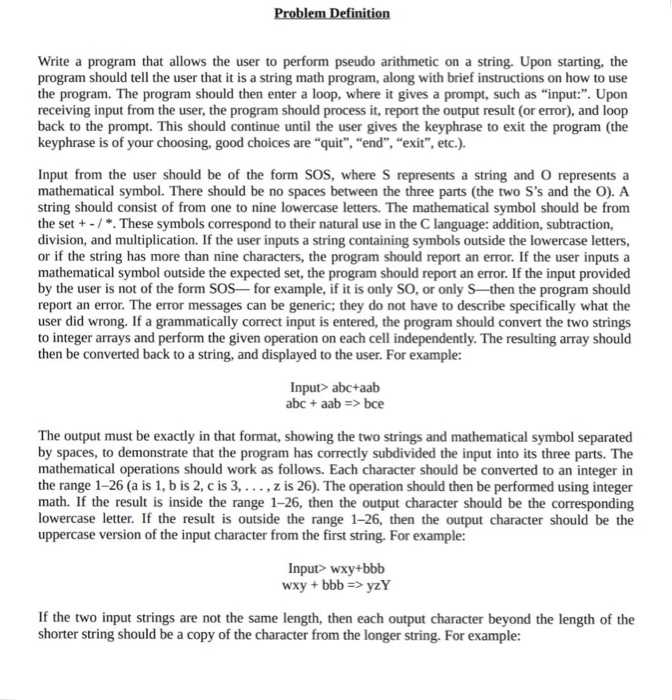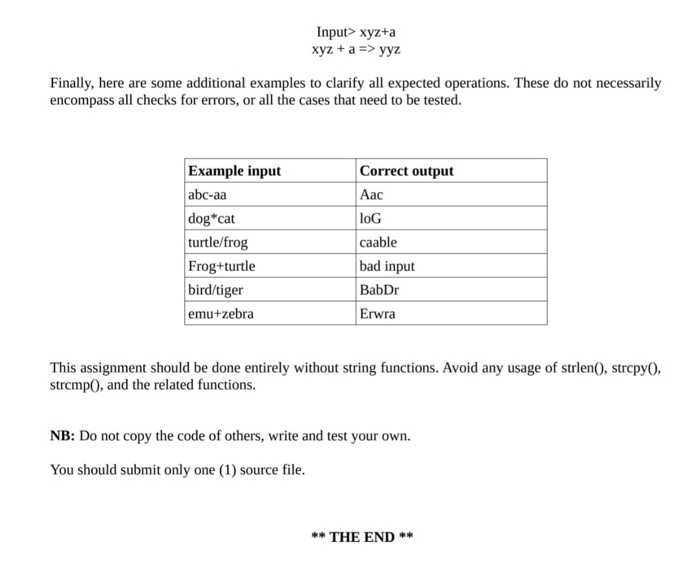Write a program that allows the user to perform pseudo arithmetic on a string. Upon starting, the program should tell the user that it is a string math program, along with brief instructions on how to use the program. The program should then enter a loop, where it gives a prompt, such as "input:". Upon receiving input from the user, the program should process it, report the output result (or error), and loop back to the prompt. This should continue until the user gives the keyphrase to exit the program (the keyphrase is of your choosing, good choices are "quit", "end", "exit", etc.). Input from the user should be of the form SOS, where S represents a string and O represents a mathematical symbol. There should be no spaces between the three parts (the two S's and the O). A string should consist of from one to nine lowercase letters. The mathematical symbol should be from the set/. These symbols correspond to their natural use in the C language: addition, subtraction, division, and multiplication. If the user inputs a string containing symbols outside the lowercase letters, or if the string has more than nine characters, the program should report an error. If the user inputs a mathematical symbol outside the expected set, the program should report an error. If the input provided by the user is not of the form SOs for example, if it is only SO, or only S-then the program should report an error. The error messages can be generic; they do not have to describe specifically what the user did wrong. If a grammatically correct input is entered, the program should convert the two strings to integer arrays and perform the given operation on each cell independently. The resulting array should then be converted back to a string, and displayed to the user. For example: Input abc+aab abc +aab >bce The output must be exactly in that format, showing the two strings and mathematical symbol separated by spaces, to demonstrate that the program has correctly subdivided the input into its three parts. The mathematical operations should work as follows. Each character should be converted to an integer in the range 1-26 (a is 1, b is 2, c is 3, z is 26). The operation should then be performed using integer math. If the result is inside the range 1-26, then the output character should be the corresponding lowercase letter. If the result is outside the range 1-26, then the output character should be the uppercase version of the input character from the first string. For example: Input wxy+bbb wxy+ bbbyzY If the two input strings are not the same length, then each output character beyond the length of the shorter string should be a copy of the character from the longer string. For example: Input> xyz+a xyz+ a yyz Finally, here are some additional examples to clarify all expected operations. These do not necessarily encompass all checks for errors, or all the cases that need to be tested. Example input abc-aa dog*cat turtle/frog Frog+turtle bird/tiger emu+zebra Correct output Aac loG caable bad input BabDr Erwra This assignment should be done entirely without string functions. Avoid any usage of strlen0, strcpy0. strcmp0, and the related functions. NB: Do not copy the code of ohers, write and test your own. You should submit only one (1) source file. **THE END* Write a program that allows the user to perform pseudo arithmetic on a string. Upon starting, the program should tell the user that it is a string math program, along with brief instructions on how to use the program. The program should then enter a loop, where it gives a prompt, such as "input:". Upon receiving input from the user, the program should process it, report the output result (or error), and loop back to the prompt. This should continue until the user gives the keyphrase to exit the program (the keyphrase is of your choosing, good choices are "quit", "end", "exit", etc.). Input from the user should be of the form SOS, where S represents a string and O represents a mathematical symbol. There should be no spaces between the three parts (the two S's and the O). A string should consist of from one to nine lowercase letters. The mathematical symbol should be from the set/. These symbols correspond to their natural use in the C language: addition, subtraction, division, and multiplication. If the user inputs a string containing symbols outside the lowercase letters, or if the string has more than nine characters, the program should report an error. If the user inputs a mathematical symbol outside the expected set, the program should report an error. If the input provided by the user is not of the form SOs for example, if it is only SO, or only S-then the program should report an error. The error messages can be generic; they do not have to describe specifically what the user did wrong. If a grammatically correct input is entered, the program should convert the two strings to integer arrays and perform the given operation on each cell independently. The resulting array should then be converted back to a string, and displayed to the user. For example: Input abc+aab abc +aab >bce The output must be exactly in that format, showing the two strings and mathematical symbol separated by spaces, to demonstrate that the program has correctly subdivided the input into its three parts. The mathematical operations should work as follows. Each character should be converted to an integer in the range 1-26 (a is 1, b is 2, c is 3, z is 26). The operation should then be performed using integer math. If the result is inside the range 1-26, then the output character should be the corresponding lowercase letter. If the result is outside the range 1-26, then the output character should be the uppercase version of the input character from the first string. For example: Input wxy+bbb wxy+ bbbyzY If the two input strings are not the same length, then each output character beyond the length of the shorter string should be a copy of the character from the longer string. For example: Input> xyz+a xyz+ a yyz Finally, here are some additional examples to clarify all expected operations. These do not necessarily encompass all checks for errors, or all the cases that need to be tested. Example input abc-aa dog*cat turtle/frog Frog+turtle bird/tiger emu+zebra Correct output Aac loG caable bad input BabDr Erwra This assignment should be done entirely without string functions. Avoid any usage of strlen0, strcpy0. strcmp0, and the related functions. NB: Do not copy the code of ohers, write and test your own. You should submit only one (1) source file. **THE END*








